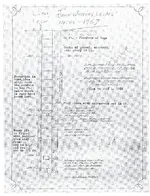Playing catchup on here is going to be the death of me! Here we go, then...
I'd be impressed if they could merely prove that it was done in the first place. Figuring out how it was done would be an interesting mental exercise, but not one that I'm willing to engage in unless there's actually something there.
That one's actually rather easy; unfortunately, others solved the problem before I tackled it. I'll pass on the kiss. They may be interested. You'll have to look around for names and universities. Moving the rock was the easy part; the only confusion here is in figuring out which method that they used. Keeping the base square is a more interesting question, until you consider that as the ruler of an empire you would certainly have access to four lengths of rope and four men of roughly equal proportions; at that point, it's a simple geometrical problem, and not a difficult one at that.

From the first page of the other thread. Pictures were a problem two centuries ago, but they were relatively commonplace in 1966. There were large amounts of coconut fibers and wooden platforms in 1966, so let's see them. People take pictures of their frigging lunches. Asking to see a picture of an historically significant find is not asking for much. Were those pictures misplaced? What about the platforms? Where did the actual physical evidence go?
But no pictures, nor physical evidence...just stories. I can prove that Zeus exists on that basis and I'll have more evidence than you to boot.
We also have witness statements that Kidd buried treasure there, supposedly from one of his crewmen. As the pirate theory is not currently in vogue, that one doesn't get discussed these days. Right up until the early part of last century though - you know, when memories were still fresh - that was the only theory.
As for the Templars, a quick perusal of my posts should show you that I'm very much not hooked on them. If anything of historical significance happened at Oak Island, I'm fairly certain that it didn't involve the Templars. (Throw the Icelanders at me if you want to watch me squirm.

)
Acknowledged. What I have pointed out elsewhere is that there are at least two other explanations for how it might have gotten there, assuming that nothing was planted. Coconut fibers do not prove Templar involvement, or Freemason involvement, or even necessarily human involvement by themselves. A large concentration might, but no large concentration has been shown. Take nothing for granted here. If a claim is made, check it out. You'll find that the more extravegant claims are just that - claims.
If Templars were not being persecuted in Scotland, what reason was there for them to leave? And if they had no reason to leave, why leave with a treasure? I've detailed in the past just how easy it would be to bury a treasure
and maintain a guard on it without anyone knowing in the past, and that was assuming a fairly populated area. There are parts of Scotland that even today are quite desolate. A trip across the water at that time with frequent stops would be hazardous, meaning that the treasure might never even make it to Iceland, never mind to the New World. Why risk it? Not every trip between the continent and Iceland was successful. Not every trip between Iceland and Greenland was successful. Not every trip from Greenland to the mainland was successful. Transoceanic voyages during that era were dangerous, and Lloyd's wasn't around to pay you off if the ship sank.
This is a sticking point with me. If I have something that I don't need, I'm not going to risk losing it, and let's face it...this is pretty risky. And I'm willing to lose it in order that someone else doesn't get it, then I'll properly lose it, and it will be at the bottom of the north Atlantic.
Is this directed at me?





 )
) Easy, the carbon dating tells you 1400 so that's when the tree produced them.......they sat around on the islands that produced them until they were collected by the Spanish and others who traveled the West Indies (you can get coconuts on Bermuda and in the Caribbean)
Easy, the carbon dating tells you 1400 so that's when the tree produced them.......they sat around on the islands that produced them until they were collected by the Spanish and others who traveled the West Indies (you can get coconuts on Bermuda and in the Caribbean) 
